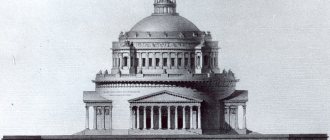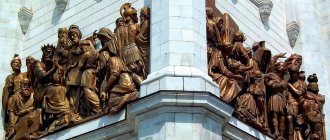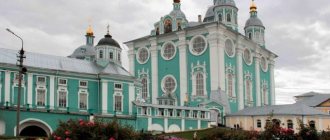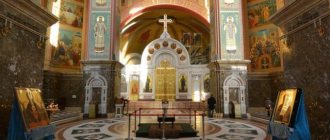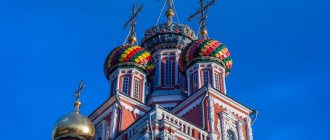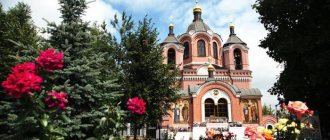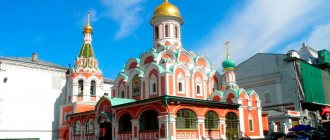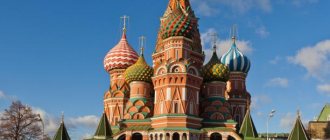| Cathedral of Christ the Savior |
The Cathedral of Christ the Savior (in the name of the Nativity of Christ) in Moscow
is the cathedral of the Moscow diocese and the entire Russian Orthodox Church not far from the Kremlin on the left bank of the Moscow River.
- Address: Russia, 119034, Moscow, st. Volkhonka, 15
- Phone: 203-38-23, 637-47-17
- Official site:
- Thrones: Main - the Nativity of Christ, southern - St. Nicholas (not consecrated), northern - Holy Blessed Prince Alexander Nevsky (not consecrated); in the lower church: the central one - the Transfiguration of the Savior, the southern one - St. Alexy, the Man of God (not consecrated), the northern one - the Tikhvin Icon of the Mother of God (not consecrated).
- On the map: Yandex.Map, Google map
The decision to build the temple “in commemoration of our gratitude to the Providence of God, which saved Russia from the destruction that threatened it” was made by Emperor Alexander I in 1812.
The initial project envisaging the construction of a temple on Sparrow Hills (architect Alexander Lavrentievich Vitberg, founded in 1817) was not implemented. A new project in the Russian-Byzantine style (architect Konstantin Andreevich Ton) was approved in 1832 by Emperor Nicholas I. The temple was refounded in 1839 on Prechistenskaya embankment, in the ancient Chertolye tract on the site of the Alekseevsky convent (the monastery buildings were dismantled and the sisters were transferred to Krasnoye Selo). The temple was built at the expense of the treasury with the participation of public donations. On May 26, 1883, the temple, which became the tallest building in Moscow and the largest temple in Russia (height 103.5 m, capacity 10,000 people), was consecrated by Metropolitan Ioannikis of Moscow and Kolomna in the presence of Emperor Alexander III. The interior decoration was made by famous Russian artists Vasily Petrovich Vereshchagin, Genrikh Ippolitovich Semiradsky, Vasily Ivanovich Surikov, Vladimir Egorovich Makovsky, Fyodor Antonovich Bruni, Ivan Nikolaevich Kramskoy and others. The author of the idea of sculptural decoration of the facades was St. Philaret, Metropolitan of Moscow, marble bas-reliefs and sculptural decor were executed by Alexander Vasilyevich Loganovsky, Nikolai Alexandrovich Ramazanov, Pyotr Karlovich Klodt and others, bronze decorations, candlesticks and chandeliers were the work of the architect Lev Vladimirovich Dahl.
In the gallery surrounding the building there were 177 marble plaques with the names of dead, wounded and decorated officers, the names of military units, and the dates of the main battles of the Patriotic War of 1812. The opening and consecration of the monument to Emperor Alexander III (author Alexander Mikhailovich Opekushin), which took place on May 30, 1912 and dedicated to the 100th anniversary of the victory in the Patriotic War of 1812, is closely connected with the Cathedral of Christ the Savior. Spiritual and educational activities were actively carried out at the temple: there was a library and general education courses for workers.
On August 15, 1917, the opening of the Local Council of the Russian Orthodox Church took place in the Temple, which restored the patriarchate. On November 5 of the same year, the first All-Russian Patriarch, St. Tikhon (Belavin), was elected in the Cathedral of Christ the Savior. In 1917–1919, the custodian of the Temple was the new martyr priest Alexander Khotovitsky.
In February 1918, to prevent the closure of the temple, the Brotherhood of the Cathedral of Christ the Savior was created, which actually maintained the temple. In 1922–1923, the temple was captured by renovationists, and in 1931 it was closed.
On December 5, 1931, by personal order of I.V. Stalin's Temple was blown up. Several high reliefs from the facades of the temple are in the Donskoy Monastery. On the site of the Temple, it was planned to build a 480 m high Palace of the Soviets (architect Boris Mikhailovich Iofan), but the project was not implemented, and in 1960 the Moscow swimming pool was opened on the site of the Temple.
By decision of February 19-20, 1990, the Holy Synod of the Russian Orthodox Church blessed the revival of the Cathedral of Christ the Savior and appealed to the Russian Government with a request to allow it to be restored to its original location [1]. In 1991, on the site of the Temple altar, a temporary chapel was built in the name of the “Sovereign” Icon of the Mother of God, which was subsequently dismantled.
On January 7, 1995, the ceremonial laying of the Temple took place. On Easter 1996, the first Easter Vespers was celebrated under the arches of the Temple. In 2000, all internal and external finishing work was completed. The consecration of the main altar by His Holiness Patriarch Alexy II of Moscow and All Rus', co-served by a council of bishops, took place on August 19, 2000. At the Temple there is a hall of Church Councils and a meeting hall of the Holy Synod. In modern times, the rector of the temple is the Patriarch of Moscow and All Rus'.
Cathedral of Christ the Savior in Tsarist Russia
The history of the Cathedral of Christ the Savior begins on December 25, 1812, when the last soldiers of Napoleon's 600,000-strong army were expelled from Russia. Emperor Alexander I ordered the construction of a majestic cathedral dedicated to Christ the Savior in order to thank God and honor the victorious Russian people and their faith in the Lord and the Fatherland.
This is interesting: The tradition of founding religious buildings in honor of victory in battle has existed in Russia since ancient times and includes St. Basil's Cathedral (celebrating the victory of Ivan the Terrible over the Kazan Khanate) and the Novodevichy Convent (celebrating the victory of Vasily III over the Lithuanians).
Tsar Alexander I organized a competition to develop a design for the cathedral, in which the most outstanding architects of the era took part. These included: Giacomo Quarenghi, Konstantin Ton and Vasily Stasov. In the end, the Tsar chose the neoclassical design of Karl Witberg. A rather unusual choice, it must be said, since Witberg was an artist, not an architect, and a Freemason, not an Orthodox believer. The first stone was laid on Vorobyovy Gory in October 1817, but unstable soil and underground streams made Vorobyovy Gory an unsuitable location for such a monumental project.
After the accession of the conservative and Orthodox Tsar Nicholas I to the throne in 1825, Witberg’s plan was rejected. He himself was put on trial for embezzling funds and exiled to Siberia. Konstantin Ton was appointed chief architect, since his Russian-Byzantine design for the cathedral was more in line with Nicholas's wishes. The cornerstone for the new cathedral was laid on September 10, 1839 on the banks of the Moscow River.
70 years after its foundation and after passing through the hands of 4 kings, the Cathedral of Christ the Savior was finally completed. It became even taller than the Kremlin Bell Tower of Ivan the Great, which until that moment was the tallest building in Moscow. The Cathedral of Christ the Savior was consecrated on the Ascension of the Lord on May 26, 1883, which coincided with the coronation of Alexander III. From that time on, divine services were regularly held in the cathedral and such important events as coronations, anniversaries and church holidays were celebrated.
This is interesting: the Alekseevsky Convent stood on the proposed site of the cathedral and was demolished. They say that the abbess of the monastery cursed Tsar Nicholas, saying: “Nothing will stand here longer than 50 years: neither the church nor the sovereign.”
Shrines
- A piece of the Robe of our Lord and Savior Jesus Christ
- Holy relics of Metropolitan Philaret (Drozdov) of Moscow
- Ark with particles of holy relics
- Robe of the Blessed Virgin Mary
- Head of Saint John Chrysostom
- Relics of Blgv. led book Alexander Nevsky
- Relics of St. Met. Jonah Moscow
- Relics of Ravnoap. led book Vladimir
- Relics of St. Mary of Egypt and Blgv. book Mikhail Tverskoy
- Relics of St. Peter Metropolitan of Moscow
- Relics of St. Basil the Great
- Relics of John the Baptist
- Relics of Ap. Andrew the First-Called
- Nail of the Holy Cross
- Relics of St. Mikhail Malein
- Relics of the Holy Martyr. Theodore Stratelates
- The relics of Vlkm. Euphemia All-praise
- Head of St. Gregory the Theologian
- Relics of St. Euphrosyne of Moscow
Based on materials from azbyka.ru
Cathedral of Christ the Savior during the USSR
After the October Revolution, the Cathedral of Christ the Savior was preserved in its original form for some time. They formed a temple brotherhood, which included parishioners and clergy, who were supposed to maintain the cathedral, conduct services, and continue educational, social and charitable activities. In addition to its religious orientation, the cathedral became a center of education in Moscow, with an excellent library and educational courses for the general public.
Soon the activities of the cathedral ceased completely. Anti-religious activity increased towards the end of the 1920s, accompanied by looting and destruction of churches throughout Russia. At the same time, the Soviet authorities were developing their own architectural plans, in particular the construction of the grandiose 420-meter Palace of the Soviets, topped with a 100-meter statue of Vladimir Lenin. The building was intended as a monument to victorious socialism and the leader of the world proletariat.
A new Moscow was supposed to arise around this palace, without the remnants of the “obscurantist past and its monuments.” They even chose a location for the palace. It became the Cathedral of Christ the Savior. By personal decision of Stalin, the demolition of the cathedral was scheduled for December 5, 1931. The destruction was preceded by a massive propaganda wave, which condemned the cathedral as “grotesque and completely inartistic” and “a poisonous mushroom on the face of Moscow.” The Cathedral of Christ the Savior was eventually blown up.
This is interesting: Some of the marble from the destroyed cathedral was used to decorate the Kropotkinskaya, Teatralnaya and Okhotny Ryad metro stations.
The Palace of the Soviets was never built. Instead, a gaping hole remained on the site of the former cathedral until 1958. Later, a huge swimming pool was built there - the largest outdoor swimming pool in the USSR.
Cathedral of Christ the Savior in post-Soviet Russia
After discussing the issue of reconstructing the Cathedral of Christ the Savior in the late 1980s, the Holy Synod of the Russian Orthodox Church finally received permission from the authorities. Yeltsin personally signed a decree putting the cathedral first on the list of priority reconstructions in Moscow. The first foundation stone was laid on December 5, 1990, 59 years after the demolition of the cathedral. Reconstruction began in 1994, and the cathedral was finally consecrated on August 19, 2000.
This is interesting: The infamous performance of Pussy Riot's punk prayer was held at the cathedral in February 2012. Three women were convicted of “hooliganism motivated by religious hatred” and sent to prison.
Today the cathedral has the shape of an isosceles cross covered with a square. Four smaller domes are located at each corner of the square, and in the center is a huge golden dome. On each side the cathedral is surrounded by six columns topped with five semicircular kokoshniks. A dark red granite porch leads to the entrance doors on each side, and the large bronze doors are decorated with images of saints and guarded by statues. The cathedral is lined with sparkling white marble.
This is interesting: the Cathedral is the largest Orthodox church in Russia and the second largest in the world. It can accommodate 10,000 worshipers.
Church of the Transfiguration
The Transfiguration Church of the Cathedral of Christ the Savior was built in memory of the Alekseevsky women's monastery located on this site. The interior decoration of the church corresponds to the 16th century, the time of the founding of the monastery. The church has three altars: the main one in honor of the Transfiguration of the Lord and two small chapels in honor of Alexy the man of God and the Tikhvin Icon of the Mother of God. “The Savior Not Made by Hands” by artist Sorokin.
The consecration and opening of the Church of the Transfiguration took place on August 19, 1996, the Liturgy was led by Patriarch of Moscow and All Rus' Alexy II. Since that day, the Church of the Transfiguration has been an active Temple.
Architecture of the Cathedral of Christ the Savior
Main Church (Upper Temple)
The interior of the Cathedral of Christ the Savior was recreated by craftsmen from the Russian Academy of Arts and rivals the interior of St. Isaac's Cathedral in St. Petersburg. Since icon painting schools were abolished under the Soviets, a special school of historical religious painting was created to repair the cathedral.
The cathedral is decorated with paintings of biblical scenes, figures and images, important people from Russian religious history and the princes of Ancient Rus', offset by borders of geometric patterns that seem almost optical illusions. The main iconostasis is an octagonal chapel made of white marble and topped with a gilded hipped roof, the icons of which depict the Nativity of Christ. This is an incredibly beautiful four-tiered iconostasis, decorated with layers of kokoshniks, intricate metal carvings and inlaid with colored stone.
This is interesting: The interior of the Cathedral of Christ the Savior is decorated with gilding with an area of 9000 m2.
The corridors along the perimeter of the cathedral contain galleries dedicated to the events of the Patriotic War of 1812. Hundreds of marble panels are engraved with descriptions of the battles of that war and the names of killed and wounded soldiers.
Church of the Transfiguration (Lower Temple)
In the basement of the cathedral there is the Church of the Transfiguration, built in honor of the Alekseevsky Convent, which previously stood on the site of the Cathedral of Christ the Savior. Its decoration is more similar to the decoration of ancient Russian churches. There are vaulted ceilings decorated with religious images, three altars and a large iconostasis that reaches to the ceiling where rare ancient icons are kept.
This is interesting: The largest bell of the Cathedral of Christ the Savior weighs 29.8 tons and rings only four times a year - on the days of the most important Orthodox holidays.
Observation deck
The Cathedral of Christ the Savior has an observation deck 40 meters above the ground that extends around the cathedral between the bell towers and offers panoramic views of the city for many kilometers around.
Visitors can admire a variety of architecture, including the sprawling cityscape of Moscow, as well as see the Kremlin, the monument to Peter the Great, the Moscow River and Patriarchal Bridge, the Seven Sisters skyscrapers, the Pushkin Museum of Fine Arts, the New and Old Arbat... the list goes on endlessly. Arrive on a clear day if possible, and be sure to use the complimentary binoculars provided at the site for the best view.
Sculptures
The cathedral is oriented along the horizon. Each facade is decorated with special sculptures:
The western façade is easily recognizable by the figure of Jesus Christ blessing the people. The high relief is located in a large central arch. On the sides of the central one there are 4 small arches. In them the sculptor placed images of Alexander Nevsky, St. Nicholas, St. Elizabeth, and Nicholas of Novgorod.
Below, above the middle gate, there are 4 angels. Their wings are open, in their hands there is a cloth on which is written: The Lord is with us. Above the small gate there are figures of 4 angels. This is a dedication to the fallen soldiers of 1812.
The archangels Jehudiel, Barachiel, Gabriel, and Uriel are located in the window arches. Yehudiel holds a wreath, the others hold flowers. In the corners there is a symbolic composition - Solomon’s crowning of the kingdom and David handing over the drawings to Solomon. This is an allegorical image of the promise of Alexander 1, fulfilled by his successor.
The eastern façade faces the Kremlin. The intercessors of Russia and those who prayed for her are depicted here. In the central arch there is a sculpture of the icon of the Vladimir Mother of God. On the sides, in small arches, are images of the Holy Queen Alexandra, the Great Martyr Catherine, Mary Magdalene, and Anna the Prophetess.
In the arch of the large gate there are sculptures of St. Stephen of Perm, St. Sergius of Radonezh, Metropolitans of Moscow Jonah and Philip. In the window arches are Joseph of Volokolamsk, Nikon of Radonezh, Mikhail and Theodore of Chernigov. In the corners of the composition are the Resurrection of Christ and the Nativity of Christ.
- What to see in Moscow in 3 days – 25 most interesting places
- 25 most interesting places in the Moscow region
The northern façade faces Prechistenka. Here are located sculptural groups of enlighteners, saints, in whose days there were battles during the campaign of Russian troops abroad. In the center is the image of the Iveron Mother of God. Along the edges are sculptures of Laurus, Gregory, Chrysanthos, and Sergius. Below are 4 evangelists and the Apostles Peter and Paul. In the corners there is a sculpture of Sergius of Radonezh, blessing Dmitry Donskoy for the battle, and Dionysius, blessing Minin and Pozharsky.
The southern façade looks out onto the Moscow River. The saints on whose days the battles of 1812 took place are depicted here. In the center is the image of the Smolensk Mother of God. On the sides are John the Baptist, Apostle Thomas, Roman of Ryazan, Jonah of Novgorod.
In the lower part is the appearance of the Archangel Michael to Joshua. Above the small gate are depicted Deborah, Barak, Moses and Miriam. In the corners there are compositions depicted: the return of David after the victory over Goliath and Abraham with his allies returning after the victory over the kings.
